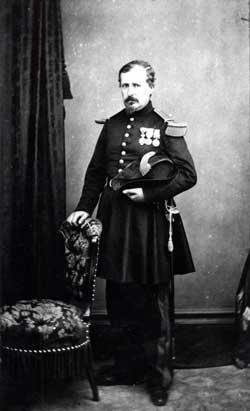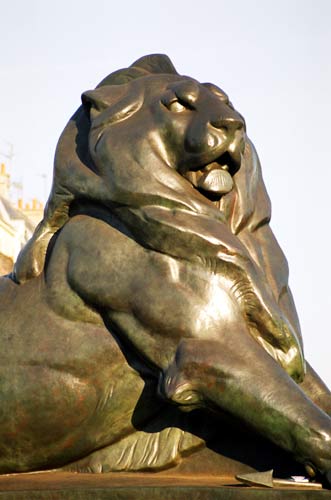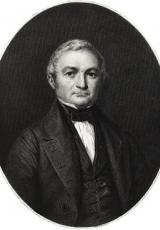Pierre Denfert-Rochereau

Pierre Marie Philippe Aristide Denfert-Rochereau was born on 11 January 1823 to a Protestant family from Jarnac in Saint-Maxent, in the department of Deux-Sèvres. After failing on his first attempt, he finally gained admission to the École Polytechnique in 1842 and opted for a career in the military in 1845, by his own admission due to his mediocre performance. Graduating first from the Ecole d'Application de l'Artillerie and Génie de Metz, the young lieutenant joined the 2nd regiment of the engineering division in Montpellier in 1847. Denfert-Rochereau participated in the conquest of Rome in 1849 before being promoted to captain and playing a role in the Crimean War, in particular in the siege of Sevastopol in 1855, where he was shot and wounded in his left leg. Repatriated to France, he taught fortification at the Ecole d'Application de Metz for five years before travelling to Algeria, where he supervised the construction of barracks, bridges and barrages.
Now a lieutenant-colonel, Denfert-Rochereau received the order from the engineer of Belfort. The officer set about developing the defences of the city, of which he would become governor in October 1870. Located south of Alsace, Belfort was an administrative centre of the administrative division, the sub-prefecture of the department of Haut-Rhin, while France was at war with the German armed forces allied with Prussia since July. From 3 November 1870, the region of Montbéliard was invaded by the powerful armies of the enemy and Denfert-Rochereau had to organise the resistance of Belfort, a fortified town blocking access to the Bourgogne. Under attack from more than forty thousand troops under the command of Werder, Denfert-Rochereau had only around fifteen thousand men, of whom just a quarter came from regular combat units. To warnings from the enemy to surrender the town, Denfert-Rochereau responded thus: "We know the scope of our responsibilities to France and the Republic, and we have decided to fulfill them". Refusing to allow the elderly, women and children to leave, the Prussian war machine used more than two hundred pieces of artillery from December 1870 and bombarded Belfort in the hope of bringing the siege to an end. Entrenched in a bunker of the tower of Bourgeois at the Brisach gate, Denfert-Rochereau refused to surrender despite the loss of life among his troops and the deterioration in the sanitation of the civilian population. Hostilities continued after the armistice of 28 January 1871, with Denfert-Rochereau refusing to surrender until 13 February, and only then on the express orders of the provisional government. After 103 days of fighting, the besieged, still twelve thousand strong, left Belfort before the Prussians, who paid them tribute. This heroic resistance saved the honour of a France wounded by the defeat of Napoléon III and Mac-Mahon in Sedan, as well as the surrender of Bazaine to Metz. It allowed Adolphe Thiers, the elected executive head of the French Republic by the National Assembly on 17 February, to secure from the victors the preservation of the administrative division of Belfort as part of France. The Treaty of Frankfurt signed on 18 May 1871 resulted in the cession of the rest of Alsace and part of Lorraine to Germany.
Elected the representative of Haut-Rhin in the National Assembly from 8 February, the hero of Belfort handed in his resignation once the preliminary peace treaties were signed. Named Commander of the Legion of Honour on 18 April 1871, Denfert-Rochereau was dismissed due to his known Republican beliefs and thus did not participate in the bloody repression of the village. Now a civilian, he was elected in three departments in the elections of 18 July 1871 and opted for Charente-Inférieure. In a National Assembly with a conservative monarchist majority, he sat with the Republican left. Re-elected in February 1876 in the VI arrondissement of Paris, he joined the Groupe de l'Union Républicaine des Gambettitstes and sided with opponents of General Mac-Mahon during the crisis of 16 May 1877. During his third term, he focussed more particularly on military issues and in particular demanded the reinstatement of the right to vote for the armed forces, who had been denied this right since 1872. He died in the palace of Versailles on 11 May 1878 and was given a state funeral. He is buried in Montbéliard.

Le lion de Denfert-Rochereau, réplique du lion de Belfort, place Denfert-Rocherau à Paris. Photo JP Le Padellec


